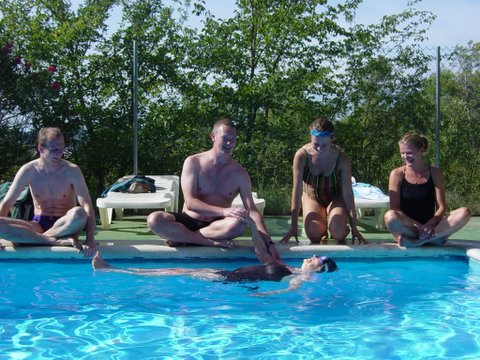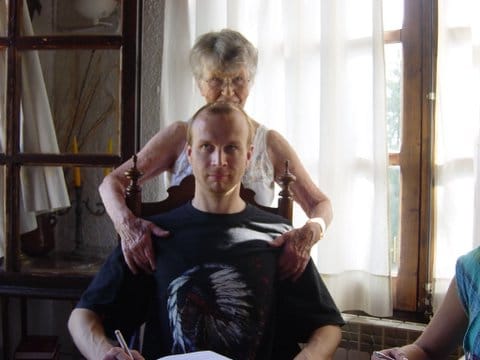F.M. Alexander said that if we chase tension round the body, it ends up in our hands and wrists. This is true in swimming.
In the Alexander Technique we practise letting our heads go up out of our backs, so that our backs expand, our limbs can flow and our feet can be springy on the ground. Sometimes we do this in order to put our hands on other people, to encourage them in the same direction.
It’s all about thinking
The moment we start to ‘do’ anything to help things along, the freedom we’re after, the bit of magic that comes when we leave ourselves alone, eludes us. Often, when working with another person in the Alexander Technique, we make an effort to get ourselves going in the right direction as the ‘teacher’ but throw it all away by tightening our hands and wrists at the moment of contact with the ‘pupil’. An extra bit of awareness is needed at this moment.
Stroking the dog
I find it useful to practise on my dogs because, while they’re responsive to what’s going on in me, they’re actually happy with any kind of touch. If my wrists are tense, they don’t seem to mind. And that makes it so much easier.
In swimming, our hands are important, just as they are in Alexander work. And the water’s a bit like the friendly dog. It won’t resist you if your hands and wrists aren’t free. But a bit of work to prevent tension in the hands and wrists goes a surprisingly long way.
Elisabeth Walker

A great Alexander teacher, Elisabeth used to say to me, ‘elbows away from shoulders, wrists away from elbows, fingertips away from wrists’. As she said this she’d be supporting my elbow gently but firmly with one hand, her other hand holding my fingers, and I would feel energy flowing out through my finger tips. Sometimes it felt like a deep stretch, sometimes like acupuncture. But neither of us was doing anything. If I was being particularly slow on the uptake, she’d say, ‘Imagine a jet of water flowing through your arm and out through your fingers.’ Or, ‘I think you need a lie down.’
Directing your arms and hands in the water
With your arms resting in the water, these directions for the arms and hands really come alive. Somehow the water helps the arms to calm down and wake up. Because it supports them, there’s nothing for them to do. So you can just experiment with thinking, not doing anything, and feel the difference.
If you then keep these directions going in the swim, especially with front crawl, everything seems to work better. Frequently I find this with people I’m teaching. There’s a lightness in the arms and a better connection with the water. Because our hands are so important in swimming, we can add more directions like ‘knuckles away from wrists, fingertips away from knuckles’. As your arm glides through the water, think of your fingertips pointing to the end of the pool, paying your arm out like rope. As your arm recovers over the water in front crawl, think of letting your hand hang from the elbow, fingertips pointing to the water before entering quietly.
Your stroke starts to feel firmer and surprisingly stronger even though you’re working to do less. It’s lovely to be soft, relaxed and free in the water but when doing less actually makes you move better, the mental effort is definitely worthwhile.



